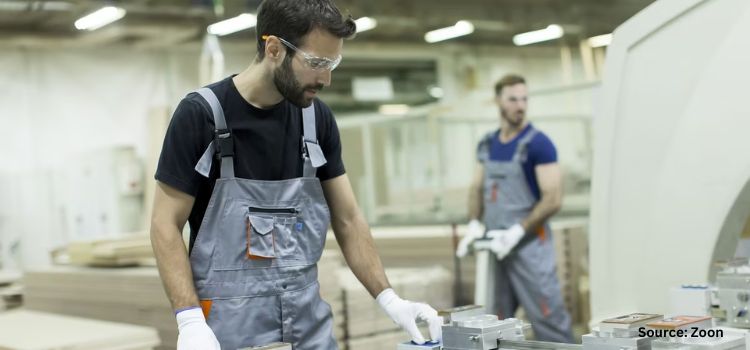
Antimicrobial Furniture Market by Surface Material (Copper, Silver, Titanium, and Others), by Furniture Type (Seating Furniture, Tables, Cupboard, and Others), by End User (Medical & Healthcare, Educational Institutes, Corporate Institutes, Malls & Shopping Stores, Household, Others), and by Distribution Channel (E-Commerce, Supermarket/Hypermarket, and Specialty Stores)– Global Opportunity Analysis and Industry Forecast, 2024–2030
Industry: Retail and Consumer | Publish Date: 02-Jan-2025 | No of Pages: 480 | No. of Tables: 290 | No. of Figures: 255 | Format: PDF | Report Code : RC456
US Tariff Impact on Antimicrobial Furniture Market
Trump Tariffs Are Reshaping Global Business
Market Overview
The Antimicrobial Furniture Market size was valued at USD 4.07 billion in 2023, and is expected to reach USD 6.94 billion by 2030, with a CAGR of 7.9% from 2024 to 2030.
Antimicrobial furniture refers to furniture items and surfaces that are designed and manufactured with materials or coatings containing antimicrobial agents, that are capable of inhibiting or reducing the growth of microorganisms such as bacteria, viruses, fungi, and mold. This type of furniture is intended to help create cleaner and more hygienic environments, particularly in settings where maintaining cleanliness and preventing the spread of harmful pathogens is paramount, such as healthcare facilities, educational institutions, hospitality establishments, and public spaces.
Healthcare-Associated Infections (HAIs) and Infection Control Drives Expansion for the Antimicrobial Furniture Industry
The prevalence of healthcare-associated infections (HAIs) and the critical importance of infection control serve as significant drivers for the growth of the Antimicrobial Furniture Market globally. With HAIs posing a substantial threat to patient safety and healthcare outcomes, there is an increasing emphasis on implementing effective infection prevention measures within healthcare facilities worldwide.
Antimicrobial furniture plays a crucial role in this regard, as it helps minimize cross-contamination and microbial transmission, thereby contributing to a safer and more hygienic healthcare environment. As healthcare providers strive to enhance infection control protocols and reduce the risk of HAIs, the demand for antimicrobial furniture solutions continues to rise on a global scale.
Regulatory Compliance and Standards Boosts the Market Growth
The stringent regulatory requirements and industry standards pertaining to hygiene and infection control serve as key drivers for the growth of the antimicrobial furniture market globally. Across various sectors such as healthcare, foodservice, and hospitality, there are strict regulations in place to ensure the maintenance of clean and sanitary environments. Antimicrobial furniture plays a vital role in meeting these regulatory requirements by offering enhanced protection against microbial contamination.
Organizations are increasingly investing in antimicrobial furniture solutions to adhere to regulatory mandates, mitigate infection risks, and safeguard the health and well-being of occupants. This emphasis on regulatory compliance and adherence to industry standards fuels the demand for antimicrobial furniture on a global scale.
Heightened Focus on Workplace Wellness to Boost Market Expansion
With the COVID-19 pandemic highlighting the importance of employee health, businesses are prioritizing measures to create safer work environments. Antimicrobial furniture, by preventing the growth of harmful microbes, plays a crucial role in promoting hygiene and safeguarding employee well-being.
By investing in antimicrobial furniture, businesses demonstrate their commitment to maintaining a clean and healthy workplace environment, fostering productivity and employee satisfaction.
Cost Considerations as a Restraint to Antimicrobial Furniture Market Growth
The initial investment required for antimicrobial furniture products tends to be higher compared to traditional furniture options. This elevated cost may discourage price-sensitive consumers and businesses from adopting antimicrobial furniture solutions, particularly in budget-constrained environments.
As a result, affordability concerns represent a significant barrier to widespread adoption and market expansion for antimicrobial furniture.
Advancement in Nanotechnology to Create Future Market Prospects
Ongoing advancements in antimicrobial technology are expected to create future opportunities for the growth of the antimicrobial furniture industry. Manufacturers are leveraging cutting-edge innovations, including nanotechnology, to develop new antimicrobial coatings and treatments.
By harnessing nanotechnology, manufacturers can create antimicrobial treatments that exhibit superior performance in inhibiting microbial growth while maintaining the integrity and aesthetics of furniture surfaces. These advancements enhance the efficacy, durability, and safety of antimicrobial furniture, addressing key consumer concerns.
North America Holds the Dominant Market Share in The Global Market
North America's growing healthcare expenditure is a primary driver behind the expansion of the antimicrobial furniture market in the region. Hospitals, clinics, and other healthcare facilities are actively seeking antimicrobial furniture solutions to mitigate the risk of infections and maintain hygienic environments.
The recent announcement by the U.S. Department of Agriculture (USDA) to award USD 110 million in grants for improving healthcare facilities in rural areas further underscores the importance of infrastructure enhancements in driving demand for antimicrobial furniture across North America.
Moreover, sustained economic prosperity, particularly evident in the United States and Canada, contributes significantly to the growth of the antimicrobial furniture market in North America. This economic affluence stimulates higher consumer spending on furniture, as individuals allocate resources towards home improvements and décor.
According to the U.S. Bureau of Labor Statistics (BLS), average annual expenditures for all consumer units witnessed a notable uptick in 2022, reflecting a substantial 9% increase from the previous year. This robust economic condition serves as a significant factor for increased investment in furniture, including antimicrobial options, thereby fueling the growth of the antimicrobial furniture market in the region.
Asia-Pacific is Expected to Show Steady Growth in the Global Antimicrobial Furniture Market
The Asia-Pacific region is poised to exhibit steady growth in the global antimicrobial furniture market, driven by several key factors unique to the region. One significant contributor to this growth is the rapid urbanization observed in countries such as China and India.
This accelerated urbanization has led to an increased demand for furniture, as newly established urban residents seek to furnish their homes. According to UN-Habitat, urbanization remains a defining megatrend in the Asia-Pacific region, encompassing more than 2.2 billion people, constituting 54% of the global urban population. Projections indicate a continued surge, with the urban population in Asia expected to grow by 50%, leading to an additional 1.2 billion people by 2050.
Additionally, the expanding hospitality sector contributes to market growth in this region. According to Coldwell Banker Richard Ellis (CBRE) Group, Inc., the world's largest commercial real estate services and investment firm, investment in Asia Pacific hotels rose to USD 10.1 billion year-to-date as of August 2022, an increase of 17% year-over-year.
Cross-border capital flows into Asia Pacific hotel assets have reached USD 932 million since the beginning of 2021. Investment is spread across a range of Asia Pacific markets, with Korea accounting for the largest share, followed by mainland China, Australia, Japan, and Singapore. This surge in investment highlights the growing hospitality sector in the region, which drives the demand for antimicrobial furniture in hotels and accommodations.
Competitive Landscape
Several market players operating in the antimicrobial furniture market include Ashley Furniture Industries, Godrej & Boyce Mfg, Herman Miller, Inc, HNI Corporation, Hille Furniture, The Home Depot, Inc, Inter IKEA Group, Action TESA, Kohler Co., La-Z-Boy Inc, and others. These market players are adopting strategies, such as product launches, across various regions to maintain their dominance in the antimicrobial furniture market.
For instance, In April 2022, IKEA announced its intention to invest approximately USD 2.2 billion in its omnichannel growth strategy in the U.S. over the next three years. This investment underscores the increasing demand for furniture solutions, including antimicrobial options, in the U.S. As part of this initiative, IKEA plans to open new stores and locations, thereby expanding its reach and accessibility to consumers across the country.
Moreover, in February 2021, Hille Furniture launched SteriTouch, a brand of additive used in the production of its antimicrobial furniture. This product is used throughout a variety of establishments including the public sector, education and healthcare, enhancing the company’s product offering.
Key Market Segments
By Surface Material
-
Copper
-
Silver
-
Titanium
-
Others
By Furniture Type
-
Seating Furniture
-
Tables
-
Cupboard
-
Other Types
By End User
-
Medical & Healthcare
-
Educational Institutes
-
Corporate Institutes
-
Malls & Shopping Stores
-
Household
-
Other End Users
By Distribution Channel
-
E-Commerce
-
Supermarket/Hypermarket
-
Specialty Stores
By Region
-
North America
-
The U.S.
-
Canada
-
Mexico
-
-
Europe
-
Germany
-
Italy
-
France
-
Spain
-
The UK
-
Netherlands
-
Denmark
-
Finland
-
Norway
-
Sweden
-
Russia
-
Rest of Europe
-
-
Asia Pacific
-
China
-
India
-
Japan
-
South Korea
-
Singapore
-
Taiwan
-
Vietnam
-
Australia
-
Rest of Asia Pacific
-
-
Rest of the World (RoW)
-
Brazil
-
South Africa
-
Nigeria
-
Israel
-
KSA
-
Turkey
-
Remaining Countries
-
Key Players
-
Ashley Furniture Industries
-
Godrej & Boyce Mfg
-
Herman Miller, Inc.
-
HNI Corporation
-
Hille Furniture
-
The Home Depot, Inc.
-
Inter IKEA Group
-
Action TESA
-
Kohler Co.
-
La-Z-Boy Inc.
REPORT SCOPE AND SEGMENTATION:
|
Parameters |
Details |
|
Market Size in 2023 |
USD 4.07 Billion |
|
Revenue Forecast in 2030 |
USD 6.94 Billion |
|
Growth Rate |
CAGR of 7.9% from 2024 to 2030 |
|
Analysis Period |
2023–2030 |
|
Base Year Considered |
2023 |
|
Forecast Period |
2024–2030 |
|
Market Size Estimation |
Billion (USD) |
|
Growth Factors |
|
|
Countries Covered |
31 |
|
Companies Profiled |
10 |
|
Market Share |
Available for 10 companies |
|
Customization Scope |
Free customization (equivalent up to 80 working hours of analysts) after purchase. Addition or alteration to country, regional, and segment scope. |
|
Pricing and Purchase Options |
Avail customized purchase options to meet your exact research needs. |

















 Speak to Our Analyst
Speak to Our Analyst




















